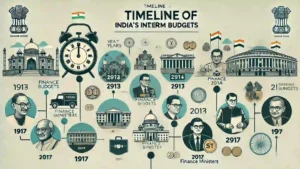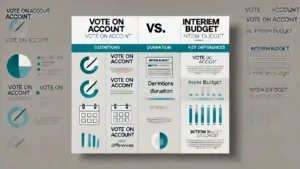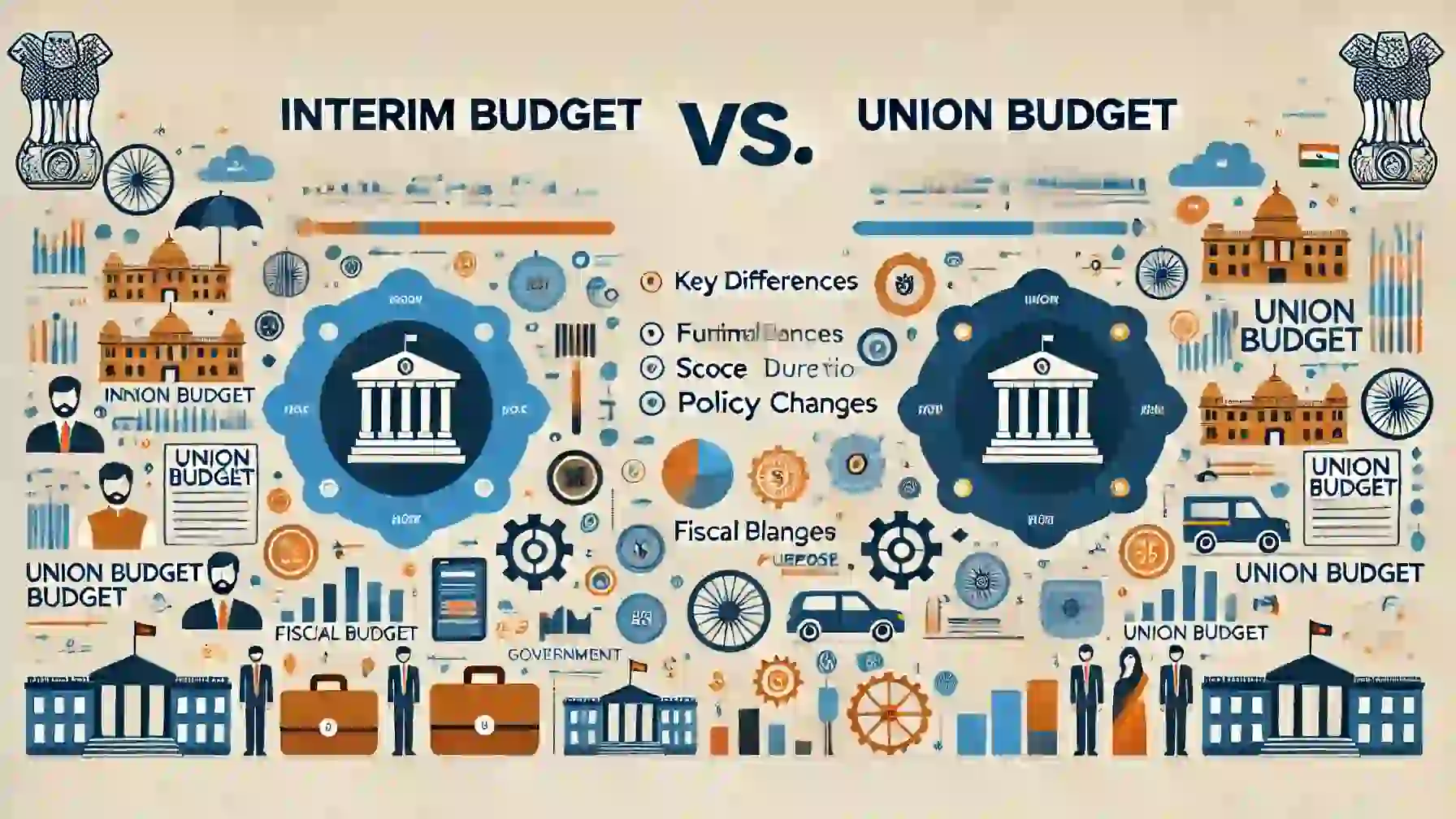Importance of Budgets in Economic Planning:
Budgets are more than just financial statements. They are comprehensive documents that reflect the government’s priorities and strategies for economic development. Through the budget, the government allocates resources to different sectors, initiates new policies, and addresses various socio-economic issues. It is a tool for economic planning, ensuring that resources are used efficiently to achieve national objectives such as economic growth, job creation, and social welfare.
Also Read: SBI Gold Loan Repayment Options and Benefits
Moreover, the budget is a means of communicating the government’s fiscal strategy to the public and the global financial community. It sets the tone for economic policies, influences market sentiment, and impacts foreign and domestic investment decisions. By providing a clear picture of government finances, the budget helps in maintaining transparency and accountability.
What is an Interim Budget?
An interim budget is a temporary financial measure. The government presents it when nearing the end of its term. It is also used during periods of political transition. Unlike the full Union Budget, it does not serve as a detailed financial roadmap. The Union Budget covers the entire fiscal year comprehensively. In contrast, the interim budget focuses on maintaining government continuity. It ensures that essential public services continue to function. This prevents any disruption until a new budget is approved.
Definition and Purpose
The primary purpose of an interim budget is to act as a stop-gap arrangement. It provides necessary funds for government operations until a new administration can present a comprehensive budget. This budget includes estimates of government revenue and expenditure for part of the financial year. It is designed to prevent any financial crisis during a transitional period.
In essence, an interim budget is a simplified version of the Union Budget. It does not include new policy announcements or tax proposals. Instead, it allows the government to manage day-to-day expenses like salaries of public servants. Routine administrative costs are covered without introducing major fiscal changes.
Historical Context and Evolution
The concept of an interim budget is not unique to India. It is a common practice in many parliamentary democracies where the government needs to manage finances during periods of transition. In India, the first interim budget was presented in 1948, just after Independence, by R. K. Shanmukham Chetty, the then Finance Minister. Since then, several interim budgets have been presented, usually during election years or when a new government is about to take office.
One of the most notable interim budgets in recent history was presented in 1991 by Yashwant Sinha. It was a time of economic crisis, and the interim budget focused on stabilizing the economy and managing fiscal deficits. Over the years, the interim budget has evolved to become an essential tool for ensuring economic stability and governance continuity during periods of political change.
What is a Union Budget?
The Union Budget is the most comprehensive financial statement of the government, detailing its revenue and expenditure for the entire fiscal year. It is presented annually and outlines the government’s economic strategy, policy initiatives, and financial allocations across various sectors. The Union Budget is a critical document that shapes the country’s economic landscape and reflects the government’s vision for growth and development.
Definition and Importance
The Union Budget is a financial plan that includes details on how the government intends to raise revenue through taxes and other sources and how it plans to allocate funds to different sectors and initiatives. It covers a wide range of areas, including taxation, public spending, fiscal policies, and social programs. The Union Budget is crucial for several reasons:
- Economic Policy: It sets the direction for the country’s economic policies and influences key sectors such as industry, agriculture, and services.
- Resource Allocation: It determines how resources will be distributed among various ministries and sectors, impacting everything from infrastructure development to social welfare programs.
- Market Impact: The budget has a significant impact on financial markets, influencing investor sentiment and the overall business environment.
- Public Welfare: It includes allocations for social programs, subsidies, and welfare schemes aimed at improving the standard of living for the population.
Key Components of the Union Budget
The Union Budget comprises several key components, each playing a vital role in the country’s financial planning and governance:
- Revenue Budget: This part of the budget deals with the government’s income and expenditure. It includes details on revenue receipts, such as taxes and non-tax revenue, and revenue expenditure, which covers the day-to-day functioning of the government.
- Capital Budget: The capital budget deals with capital receipts and payments. It includes expenses on assets like infrastructure projects, buildings, machinery, and loans to states and union territories.
- Fiscal Deficit: The fiscal deficit is the difference between the government’s total expenditure and its total revenue (excluding borrowings). It indicates the amount the government needs to borrow to meet its expenses.
- Primary Deficit: This is the fiscal deficit minus interest payments. It shows the extent to which the government’s expenditure, excluding interest payments, exceeds its revenue.
- Revenue Deficit: This occurs when the government’s revenue expenditure exceeds its revenue receipts. It indicates the government’s inability to meet its day-to-day expenses from its revenue.
- Expenditure Budget: This section includes details on the allocation of funds to various ministries and departments, such as defense, health, education, and infrastructure.
Tax Proposals: The Union Budget includes proposals for changes in tax rates, introduction of new taxes, and removal of existing ones. These proposals significantly impact individuals, businesses, and the overall economy.
Key Differences Between Interim and Union Budgets:
Understanding the differences between the interim budget and the Union Budget is crucial for comprehending how government finances are managed during different phases of governance. While both serve as financial statements, they differ significantly in scope, duration, and purpose.
Scope and Duration
The primary difference between the two lies in their scope and duration. The Union Budget is a comprehensive financial plan for the entire fiscal year, covering all aspects of government revenue and expenditure. It includes detailed proposals for taxation, sectoral allocations, and policy initiatives aimed at long-term economic growth.
In contrast, the interim budget is a temporary arrangement that provides a financial roadmap for a shorter period, usually a few months. It is typically presented when the government’s term is coming to an end, and elections are imminent. The interim budget focuses on essential expenditures and does not include major policy changes or long-term financial commitments.

Policy Changes and Fiscal Planning
The Union Budget is a tool for long-term fiscal planning. It includes new policy announcements, tax reforms, and sectoral allocations aimed at achieving the government’s economic objectives for the year. The Union Budget is an opportunity for the government to introduce significant policy changes, such as new tax structures, subsidies, and development programs.
On the other hand, the interim budget is not meant to introduce new policies or reforms. It is a stop-gap arrangement that ensures the government has the necessary funds to continue its operations until a new budget is approved. Any significant policy changes or reforms are usually deferred until the full Union Budget is presented by the new government.
Presentation Timeline
The Union Budget is typically presented on the first day of February each year, marking the beginning of the budget session in Parliament. It is followed by a detailed debate and discussion in both houses of Parliament before being approved.
The interim budget, however, is presented a few months before the end of the financial year, usually in January or February, before general elections. It serves as a temporary financial plan until a new government takes office and presents a full-fledged Union Budget.
Situations Leading to an Interim Budget:
An interim budget is presented under specific circumstances, usually related to political transitions or unexpected financial needs. Understanding these situations helps in grasping the role and importance of an interim budget in the governance framework.
Political Transitions
One of the most common situations leading to an interim budget is political transition. This includes the end of a government’s term or the dissolution of Parliament before elections. During these times, the government needs a temporary financial arrangement to manage expenses. This is required until a new administration can present a full budget.
For instance, if general elections are scheduled for April or May, an interim budget is presented in February. The outgoing government uses this budget to cover financial requirements for the remaining months of the fiscal year. This process ensures that the government can continue operations without financial disruption.
Unexpected Circumstances Requiring Stop-Gap Funding
An interim budget may also be presented in response to unexpected circumstances that require immediate financial attention. This could include situations like natural disasters, economic crises, or other unforeseen events that necessitate additional government spending. In such cases, an interim budget provides the government with the necessary funds to address these issues without waiting for the full budget cycle.
The Role of an Interim Budget in Governance:
The interim budget plays a crucial role in maintaining the stability and continuity of government operations during periods of transition. It ensures that the government has the necessary funds to carry out its functions and that essential services are not disrupted.
Ensuring Continuity of Government Operations
The primary function of an interim budget is to ensure the continuity of government operations. It allows the government to allocate funds for essential services such as healthcare, education, defense, and public safety. Without an interim budget, the government would be unable to incur expenditure, leading to a potential financial crisis and disruption in public services.
Allocation of Essential Funds
The interim budget provides for the allocation of essential funds to various ministries and departments, ensuring that critical government functions continue without interruption. This includes salaries for government employees, funding for ongoing projects, and operational expenses for public services. The interim budget thus plays a vital role in maintaining the smooth functioning of the government during transitional periods.
Presentation Process of an Interim Budget:
The presentation of an interim budget follows a structured process, similar to that of the Union Budget but with a more expedited timeline. Understanding this process provides insights into how the government manages its finances during transitional periods.
Procedure and Timeline
The interim budget is usually presented in January or February, a few months before the end of the financial year. It is prepared by the Ministry of Finance, which consults with various government departments to estimate the revenue and expenditure for the interim period. Once the budget is finalized, it is presented in Parliament by the Finance Minister.
The presentation of the interim budget is followed by a general discussion in both houses of Parliament. Unlike the Union Budget, which goes through a detailed scrutiny process, the interim budget is usually passed quickly to ensure that the government has the necessary funds to continue its operations.
Approval and Implementation
After the presentation, the interim budget needs to be approved by both houses of Parliament. Once approved, it becomes a temporary financial plan for the government, allowing it to incur expenditure and manage its finances until a new budget is presented.
The implementation of the interim budget is relatively straightforward, as it primarily focuses on maintaining the status quo and does not involve any major policy changes or new financial commitments. It provides the necessary funds for government operations without introducing significant changes to taxation or expenditure policies.
Presentation Process of a Union Budget:
The Union Budget is one of the most significant financial events in India, outlining the government’s plans for the upcoming fiscal year. The presentation process of the Union Budget is detailed and involves multiple stages, from planning and preparation to parliamentary approval.
Planning and Preparation
The preparation of the Union Budget begins several months before it is presented in Parliament. The Ministry of Finance coordinates with various government departments, state governments, and industry representatives to gather inputs and suggestions for the budget. This stage involves extensive consultations and discussions to ensure that the budget reflects the government’s economic priorities and policy objectives.
The Finance Minister plays a central role in this process, reviewing the recommendations and finalizing the budget proposals. The budget is then reviewed by the Prime Minister and the Cabinet before being presented to Parliament.
Parliamentary Approval
The Union Budget is presented on the first day of February, marking the beginning of the budget session in Parliament. It is followed by a detailed debate and discussion in both houses of Parliament, where members scrutinize the budget proposals and suggest amendments.
The budget is then passed in two parts: the Finance Bill and the Appropriation Bill. The Finance Bill includes the government’s proposals for changes in taxation, while the Appropriation Bill authorizes the government to incur expenditure. Once both bills are approved by Parliament, the budget is finalized and implemented for the upcoming fiscal year.
Impacts of Interim Budget on Economy:
The interim budget, while limited in scope, has a significant impact on the economy, particularly in terms of maintaining stability and continuity during periods of transition. Understanding these impacts provides insights into how the interim budget influences economic performance and market sentiment.
Short-Term Economic Stability
The interim budget plays a crucial role in maintaining short-term economic stability by ensuring that the government has the necessary funds to continue its operations. It provides financial support for essential services such as healthcare, education, and public safety, preventing any disruption in these critical areas.
Moreover, the interim budget helps in managing public expectations and market sentiment during transitional periods. By providing a clear financial plan for the interim period, it reassures investors, businesses, and the public that the government is committed to maintaining economic stability.
Effects on Public and Private Sector
The interim budget affects both the public and private sectors. It determines the allocation of government funds for various projects and programs. For the public sector, it ensures adequate funding for ongoing projects and essential services. This support allows for the continued functioning of government operations without disruption.
For the private sector, the interim budget influences business confidence and investment decisions. It does not introduce major policy changes or reforms. However, it provides a sense of stability and continuity, crucial for businesses. This stability is especially important during periods of political transition.

Impacts of Union Budget on Economy:
The Union Budget has a far-reaching impact on the economy, influencing everything from market sentiment to foreign investment. It sets the tone for the government’s economic policies and determines the allocation of resources across various sectors.
Long-Term Economic Policies and Growth
The Union Budget is a tool for long-term economic planning and growth. It includes detailed proposals for taxation, public spending, and policy initiatives aimed at boosting economic growth, generating employment, and reducing poverty. The budget’s impact on long-term economic growth depends on the effectiveness of these policies and their implementation.
For example, the Union Budget may include measures to promote industrial growth, such as tax incentives for manufacturing or increased investment in infrastructure. These measures can have a significant impact on economic growth by boosting productivity, creating jobs, and attracting investment.
Sectoral Allocations and Reforms
The Union Budget includes sectoral allocations that determine how resources will be distributed among various sectors such as agriculture, healthcare, education, and defense. These allocations have a direct impact on the performance of these sectors and their contribution to the overall economy.
For instance, increased funding for the agricultural sector can boost farm productivity and rural incomes, while higher allocations for healthcare can improve public health outcomes and reduce healthcare costs. Similarly, investments in infrastructure can enhance connectivity, reduce transportation costs, and promote industrial growth.
Vote on Account vs. Interim Budget:
The Vote on Account and the interim budget are two distinct financial measures used by the government to manage finances during transitional periods. While they serve similar purposes, they differ in scope, duration, and implications.
Definition and Purpose of Vote on Account
A Vote on Account is a temporary financial provision. It allows the government to withdraw funds from the Consolidated Fund of India. This withdrawal is essential to meet government expenses until a full budget is passed. It is presented when the full budget cannot be passed before the financial year ends. This provision enables the government to continue its operations without disruption.
The primary purpose of a Vote on Account is to fund the day-to-day functioning of the government. This includes salaries for employees, administrative expenses, and routine maintenance costs. It does not introduce new policy proposals or changes in taxation. Typically, it is limited to a few months, ensuring uninterrupted government operations.
Key Differences with Interim Budget
While both the Vote on Account and the interim budget serve as temporary financial arrangements, there are several key differences between the two:
- Scope: The interim budget includes detailed estimates of revenue and expenditure for a part of the financial year, while the Vote on Account only provides for essential expenses until the full budget is passed.
- Duration: The interim budget covers a longer period, usually a few months, while the Vote on Account is typically for a shorter duration, often just a few weeks.
- Policy Changes: The interim budget may include minor adjustments to existing policies, but the Vote on Account does not include any policy changes or new proposals.
Purpose: The interim budget serves as a stop-gap arrangement during periods of political transition, while the Vote on Account is used when the government needs additional time to pass the full budget.
Major Differences Between Interim and Full Union Budgets:
Understanding the major differences between the interim budget and the full Union Budget is essential for comprehending how government finances are managed during different phases of governance.
Scope, Duration, and Policy Changes
The interim budget is limited in scope and duration, focusing primarily on essential expenditures and avoiding major policy changes. It is presented when the government’s term is nearing its end, and a new administration is expected to take office. The interim budget provides a financial plan for a few months, ensuring the continuity of government operations during the transitional period.
The Union Budget, on the other hand, is a comprehensive financial plan for the entire fiscal year. It includes detailed proposals for revenue generation, sectoral allocations, and policy initiatives aimed at achieving long-term economic growth and development. The Union Budget is an opportunity for the government to introduce new policies, tax reforms, and development programs that align with its economic objectives.
Economic and Political Implications
The interim budget has limited economic and political implications, as it does not introduce major policy changes or new initiatives. It is primarily aimed at maintaining stability and continuity until a new budget is presented. The interim budget is often seen as a reflection of the outgoing government’s priorities and approach to managing finances during a transitional period.
The Union Budget, however, has significant economic and political implications. It reflects the government’s long-term economic strategy and priorities and can influence everything from market sentiment to voter perceptions. The Union Budget is a critical tool for the government to showcase its achievements and set the agenda for the coming year.
Real-World Examples: Analysis of Recent Interim and Union Budgets
Analyzing recent interim and Union Budgets provides valuable insights into how governments use these financial tools to manage the economy and address various challenges. Each budget reflects the government’s priorities and approach to economic management, influencing everything from market sentiment to public perception.
Case Study: Interim Budget 2024
The Interim Budget 2024 was presented during a period of political uncertainty, as general elections were scheduled for later in the year. The budget focused on maintaining economic stability and ensuring the continuity of government operations without introducing significant policy changes.
Key highlights of the Interim Budget 2024 included increased funding for rural development programs, support for small and medium-sized enterprises (SMEs), and allocations for healthcare and education. The budget aimed to address immediate financial needs and provide a foundation for the incoming government to build upon.
Case Study: Union Budget 2023-24
The Union Budget 2023-24 was presented by the newly elected government, outlining its vision for economic growth and development. The budget included several key policy initiatives aimed at boosting industrial growth, promoting digitalization, and enhancing social welfare.
Major highlights of the Union Budget 2023-24 included tax reforms to encourage investment, increased funding for infrastructure development, and measures to support the agricultural sector. The budget also introduced new programs aimed at improving healthcare and education outcomes, reflecting the government’s commitment to social development.
Common Misconceptions About Interim and Union Budgets
There are several common misconceptions about interim and Union Budgets that can lead to confusion and misunderstandings. Addressing these myths helps in clarifying the purpose and scope of each type of budget.
Addressing Popular Myths and Misunderstandings
1. Myth 1: Interim Budget Can Implement Major Policy Changes
Fact: The interim budget is a temporary financial arrangement that does not include major policy changes or new initiatives. It focuses on maintaining continuity and stability during transitional periods.
2. Myth 2: Vote on Account and Interim Budget Are the Same
Fact: While both serve as temporary financial measures, they differ in scope and purpose. The interim budget includes detailed estimates of revenue and expenditure, while the Vote on Account only covers essential expenses until the full budget is passed.
3. Myth 3: Interim Budget Is the Same as a Mini Budget
Fact: The interim budget is not a mini budget. It is a simplified version of the full budget, focusing on essential expenditures without introducing new policies or tax proposals.
4. Myth 4: Union Budget Only Impacts the Central Government
Fact: The Union Budget has a significant impact on state governments as well, as it includes allocations for various centrally sponsored schemes and programs that are implemented at the state level.
5. Myth 5: Budget Announcements Are Immediately Implemented
Fact: While some budget proposals are implemented immediately, others require parliamentary approval and may take several months to be enacted.
Clarifying the Scope and Purpose
Understanding the scope and purpose of each type of budget is essential for comprehending how government finances are managed during different phases of governance. The interim budget serves as a temporary financial plan, ensuring the continuity of government operations during periods of transition. The Union Budget, on the other hand, is a comprehensive financial statement that sets the government’s economic agenda for the entire fiscal year.
FAQs on Interim and Union Budgets:
1. What is the purpose of an interim budget?
An interim budget serves as a temporary financial plan until a new government can present a full-fledged budget post-elections. It ensures the continuity of government operations without introducing significant policy changes.
2. How is it different from a regular Union Budget?
Unlike the comprehensive Union Budget, an interim budget focuses on essential expenditures to keep the government running until a permanent administration can introduce detailed fiscal policies.
3. Can significant policy changes be implemented in an interim budget?
Typically, major policy decisions are deferred to the full-budget presentation due to the limited scope of adjustments possible during an interim period.
4. Are long-term investments usually included in an interim budget?
Interim budgets primarily cover short-term expenses and maintenance costs rather than extensive investment strategies or ambitious development plans.
5. What happens if the interim budget is not passed?
If the interim budget is not passed, the government would be unable to incur expenditure, leading to a financial crisis and potential disruption in public services.
6. How does an interim budget affect the stock market?
The impact on the stock market is usually minimal as the interim budget does not introduce new policies or reforms. However, it can influence market sentiment if it includes provisions for specific sectors or industries.

Climate Action in India’s Interim Union Budget:
As climate change continues to impact our planet, the inclusion of environmental considerations in India’s interim Union Budget is crucial. The allocation of funds towards sustainable initiatives and renewable energy sources is essential for a greener future.
India’s commitment to reducing carbon emissions and promoting clean energy reflects a proactive approach towards combating climate change. Investments in green infrastructure and conservation efforts highlight the government’s dedication to environmental sustainability.
Incorporating climate action into budget planning signifies a shift towards prioritizing long-term ecological health over short-term gains. By focusing on eco-friendly policies and green technologies, India sets an example for other nations striving for environmental stewardship.
The emphasis on sustainability in the interim Union Budget underscores the importance of balancing economic growth with environmental protection. As we navigate complex global challenges, addressing climate change through budgetary measures becomes imperative for fostering a more resilient and sustainable society.
Latest Thinking on the Interim Union Budget FY25:
As we look ahead to the Interim Union Budget for FY25, there is anticipation and curiosity surrounding the government’s fiscal plans. Analysts and experts are buzzing with discussions on potential policy shifts, allocations, and economic strategies that might be unveiled in this budget. The focus is not just on numbers but also on the vision it carries for India’s economic growth.
There are speculations about new initiatives catering to different sectors such as infrastructure, healthcare, education, and agriculture. Stakeholders across industries are closely watching how the budget will address current challenges while setting a roadmap for future development. With global trends impacting local economies more than ever before, there is heightened interest in understanding how this budget aligns with international standards and best practices.
The buzz around the Interim Union Budget FY25 reflects a blend of optimism and caution among investors, businesses, policymakers, and citizens alike. It signals a critical juncture in shaping India’s economic trajectory amidst evolving domestic and global landscapes. Stay tuned for updates as we delve deeper into analyzing the implications of this crucial financial plan!
Summary of the Interim Union Budget 2024-25:
The Summary of the Interim Union Budget 2024-25 provides a snapshot of the government’s financial roadmap for the upcoming fiscal year. It outlines key allocations and projections across various sectors, reflecting the administration’s priorities and focus areas. This budget aims to address pressing economic challenges while setting the stage for sustainable growth and development in India. With detailed insights into revenue generation, expenditure patterns, and sector-wise allocations, it offers a comprehensive overview of the country’s financial landscape.
The budget projections indicate a strategic approach towards boosting infrastructure, healthcare, education, and other critical sectors vital for national progress. The interim budget sets a tone for prudent fiscal management and targeted investments to propel India towards greater economic resilience and prosperity in FY 2024-25.
Insights from Previous Budgets and Future Implications:
Exploring insights from previous budgets offers valuable lessons for understanding future implications. Past budgetary decisions have shaped the economic landscape, influencing various sectors in diverse ways. By analyzing historical trends and outcomes, experts can anticipate potential impacts on industries moving forward.
The allocation of funds in previous budgets has had a direct correlation with the growth or stagnation of different sectors. Understanding these patterns helps policymakers make informed decisions to drive sustainable development and address emerging challenges effectively.
Evaluating the effectiveness of past budget measures helps stakeholders refine strategies. It also optimizes resource utilization in future fiscal plans. Anticipating policy outcomes based on historical data is crucial. It allows adaptation to evolving economic conditions and changing market dynamics.
By examining past budget implementations, stakeholders can forecast potential influences on key sectors. These include infrastructure, healthcare, and education. Such foresight is vital for crafting robust financial blueprints. It ensures they cater to changing needs and promote long-term prosperity across diverse industries.
Impact of Past Budgets on various sectors:
Exploring the impact of past budgets on various sectors unveils a tapestry of economic shifts and trends. Each budget leaves its mark, shaping industries in distinct ways. The allocation of funds can bolster growth in technology, healthcare, or education while affecting infrastructure development differently.
Past budgets have influenced consumer behavior and market dynamics significantly. Changes in taxation policies, subsidies, and incentives can drive consumption patterns and investment decisions across sectors like real estate, agriculture, and manufacturing.
Moreover, the evolution of regulatory frameworks through budgetary measures has a profound effect on sectoral performance. Industries adapt to new norms set by government interventions that aim to spur growth or address challenges faced by specific sectors.
By analyzing the outcomes of previous budgets on diverse industries, policymakers can refine strategies for future allocations to optimize sectoral productivity and resilience amidst changing market conditions.
Foreseeing Potential Influences on Different Industries:
The interim and Union budgets play a significant role in shaping the landscape of various industries. By analyzing past trends and proposed allocations, experts can anticipate potential impacts on different sectors. Industries like agriculture, healthcare, infrastructure, and technology closely monitor budget announcements for clues on future developments. Changes in tax policies, subsidies, and investments can directly influence the growth trajectory of businesses within these sectors.
For example, increased funding for digital infrastructure could boost the IT industry, while enhanced support for renewable energy projects may drive growth in the clean energy sector. Similarly, changes in import duties or export incentives could have ripple effects across manufacturing industries. It’s essential for stakeholders to stay informed about budget implications to adapt their strategies accordingly.
Understanding how budgetary decisions can affect specific industries is crucial for forecasting market dynamics and planning business strategies effectively.
Social Engagements and Media Coverage:
When it comes to social engagements and media coverage surrounding the interim and Union budgets, there is a buzz of anticipation. Analysis is widespread. Various platforms, including traditional news outlets and social media channels, are abuzz with discussions. Conversations focus on budget allocations and their potential impact on the economy and society.
Experts share their insights, pundits analyze projections, and citizens voice their opinions on how these financial plans may affect them directly or indirectly. It’s a time when information flows freely, allowing everyone to stay informed about the government’s fiscal roadmap.
From Twitter threads dissecting budgetary nuances to detailed articles in leading newspapers outlining key highlights, there is no shortage of sources for those eager to delve deeper into budget-related news. Staying updated through reputable sources ensures that you have a well-rounded understanding of the economic landscape moving forward.
Platforms for Detailed Information and Insights
When it comes to seeking detailed information and insights on interim and Union budgets, there are several platforms that cater to the needs of individuals and businesses alike. Online portals dedicated to finance and economics offer in-depth analysis, expert opinions, and live coverage of budget announcements.
Social media channels like Twitter, LinkedIn, and Facebook also play a crucial role in disseminating real-time updates and reactions from industry experts, policymakers, and the general public. Following relevant hashtags can provide a wealth of information at your fingertips.
Furthermore, financial news websites such as Bloomberg, CNBC, Moneycontrol, or Economic Times are trusted sources for comprehensive coverage of budget-related news. They often feature interviews with top economists discussing the potential impact of budgetary allocations on different sectors.
For those who prefer visual content, YouTube channels hosted by financial analysts or government officials offer video summaries and breakdowns of key budget highlights. Podcasts focusing on economic policy changes can also be informative sources for gaining a deeper understanding of budget implications.
Links to Stay Updated on Budget-Related News:
For those eager to stay informed on the latest budget updates, keeping track of reliable sources is key. One great way to stay in the loop is by following reputable financial news websites that provide timely coverage and analysis on budget-related news. Websites like Bloomberg, Financial Times, and CNBC often offer detailed insights and expert opinions on budget developments.
In addition to traditional news outlets, government websites such as the Ministry of Finance can be excellent resources for accessing official documents and statements related to the budget. These platforms often publish press releases, speeches, and detailed reports that shed light on the government’s fiscal plans.
Another valuable source for staying updated on budget-related news is social media platforms like Twitter and LinkedIn. Many finance professionals, economists, and journalists share real-time updates and commentary on these platforms, providing a unique perspective on budget announcements.
Podcasts focusing on economics and finance are also becoming increasingly popular among those interested in understanding complex budgetary matters in a more digestible format. Tuning into podcasts featuring experts discussing budgets can offer valuable insights that complement traditional news sources.
By diversifying your sources of information and staying engaged with various mediums covering budget-related news, you can gain a comprehensive understanding of the intricate world of fiscal planning.
Conclusion:
As we wrap up our exploration of the interim budget and Union budget disparities, it’s clear that these fiscal plans play a crucial role in shaping India’s economic landscape. From the interim budget serving as a temporary measure to the full Union Budget laying out comprehensive financial strategies, each has its significance.
Understanding the nuances between these budgets is essential for grasping their impact on various sectors and industries. The vote on account vs. interim budget distinctions shed light on different aspects of financial planning and allocation processes.
Also Read: Simplifying Pension Management with Pension Seva SBI
With climate action increasingly becoming a focal point in budget discussions, there is growing attention towards environmental considerations in fiscal policies. As we delve into past budgets’ influence and future implications, it becomes evident that every budget decision carries far-reaching consequences.
Engaging with media coverage and staying informed about budget updates are vital steps towards gaining insights into India’s economic roadmap. By being aware of key projections and allocations in each year’s budgets, individuals can better comprehend the government’s priorities and initiatives moving forward.









